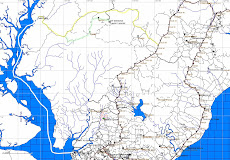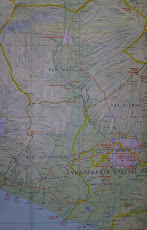In search for improving fuel economy of my motorcycle,
I found “hypermiler” community,
a group of people who develop driving technique to reduce their fuel consumption,
whatever vehicle they are driving. Instead of relying on additional tools
and gadgets, hypermiler rely mainly on mastering the control of the vehicle
they are driving to reduce its fuel consumption.
I found that some of those hypermiler techniques,
are really close to what cyclists are doing.
Cyclist commuters will minimize the effort while cycling,
will coast freely downhill, keeping their cadence constant
and shift to lower gear whenever climbing,
and hate “stop and go” situation since it demands more energy.
Cyclists are also keen to avoid pot holes and uneven road surface,
and conserve their momentum while making turn on corner.
Instead of braking – turning - and then accelerating,
cyclists will coast down, taking long smooth turn without braking too much.
Cyclists are checking tire pressure and know that less pressure means heavier effort.
They care to lube bicycle chain and align the brakes correctly,
since any friction will increase the pedaling effort.
They also leave home earlier and give ample time for the trip, avoiding rush situation,
since going faster on bicycle will make the rider tired very quickly to.
After finding technical similarities of cyclist commuter and hypermiler,
then I start to apply those techniques while I am riding my motorcycle.
And guess what, it is not too difficult.
First thing to do is planning the route,
while commuting on bicycle I avoid hilly area,
I prefer to take little longer distance rather than big climb uphill.
Luckily I have passed those routes around already on my bicycle,
and I remember well which one is requiring more effort on my feet,
so that route is to be avoided.
While planning the route, I also estimate the timing,
and ensure that I will have enough time for this route.
Departing earlier helps, we simply cannot economize any fuel if we are in rush.
Second thing is checking the motorcycle, ensure that tires are properly inflated.
I always put maximum pressure on my motorcycle even if it is slightly less comfortable.
I also ensure that the chain is well lubed.
Now come to riding, I always gentle on throttle,
I am asking for “minimum energy” from my motorcycle.
Instead of open the throttle more to climb uphill,
I will accelerate before climbing,
then maintaining the throttle position while going uphill,
speed will decrease, and I will downshift the gear and keeping same throttle position.
If the uphill slope is long I may need to downshift further,
but I will not open more throttle
and asking more power from my motor engine, unless I have safety concern.
Going downhill, I will coast the motor all the way down,
often by pull the clutch to disengage the engine from the rear wheel.
Attention, we will not have engine brake in this condition,
and it is not always possible to do,
and I only do this if the traffic condition and road condition allow.
Consequently, the speed while I am riding will not be constant,
I am going slower and slower uphill,
and I have to take the most outer lane not to disturb other drivers behind me.
And while going downhill it will be the inverse.
On flat road I will not go fast,
as in bicycle if I push myself too fast I will be tired even faster,
and probably I have to stop before arriving.
So I limit motorcycle speed to a “minimum comfort cruising speed” at highest gear.
This speed will vary from one type of motorcycle to another,
but usually it will be around 4000-4500 RPM at highest gear.
With bicycle I learned to anticipate the traffic,
I will not pedaling with full effort if there is an obstruction ahead,
since I will only braking hard later.
And I apply the same principle on my motorcycle.
Whenever I approach traffic light, I will adjust the speed,
so either the light turns green at the time I arrive,
or the motorcycle stopped by itself without applying too much braking.
Once I arrive at home on motorcycle I will check the brake by hand,
if the brake disk is hot means that the adjustment is too tight,
or I just applying the brake too often.
Be careful, the brake disk can be extremely hot.
Applying those hypermiling techniques above on my motorcycle,
I can have a good fuel economy.
Before applying those techniques, my fuel consumption at it best was 1ltr every 40kms,
and now it is almost constantly 1ltr every 50kms, so about 25% more economic.
I did few other things as written in hypermiling discussion in the internet,
that also help to improve my fuel economy:
- Facing the motorcycle to the road before starting the engine,
avoid repositioning the motorcycle with engine running.
- Avoid parking motorcycle under direct sunlight to reduce fuel evaporating.
- Fully closed helmet will reduce wind resistance, which is good.
- Always minimize frontal exposure while riding, beware of feet and body position.
Tucking the body in even at relatively low speed, say 50kph,
still helps to reduce drag.
Applying those hypermiling techniques above while riding motorcycle is not too difficult,
and some techniques could be applied on car driving as well.
With little practice and patience, we all can reduce our fuel consumption.
It just seems easier for cyclist to practice hypermiling,
since there are natural similarities between the two.
Subscribe to:
Post Comments (Atom)




No comments:
Post a Comment